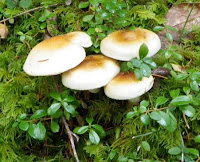And my cousin Maddy and I near a waterfall, with the glacier in the background:
In theory, I have seen glaciers before. In Wyoming and Colorado I've seen patches of snow high in the mountains that never melt. But a real, active glacier is entirely different. It really is a river of ice. The Mendenhall glacier is one of several glaciers flowing out of the Juneau Icefield, which an area of mountains where snowfall always exceeds the melt. Snow builds up, compacts into beautiful, deep blue ice, and is squeezed out into glaciers that run the excess ice out to lower ground (or sometimes directly to the sea). It's like a giant lake of ice with ice rivers spilling out over natural dams. Here's a picture that really shows the river nature of the glacier:
The glacier flows at a rate of about two feet a day, and is about 12 miles long, measuring from the icefield to the Mendenhall Lake. That means it takes upwards of 80 years for ice to travel from the icefield to the lake. Add 20 years for snowfall to compact and make its way through the icefield, that little chunk of ice in my hand a few pictures back was 100 years old! Pretty cool!
Maddy and I climbed up the valley above the glacier to get some good views. Here's a look back down the valley towards the lake:
And here's a closeup of the lake (now freezing over, because it's November) with icebergs floating in it:
On the way back down we took a detour down a largely unmarked trail (Caution! Dangerous Unmaintained Trail Ahead!) to go touch the glacier. We had to hurry because the light was fading fast (sunset is at about 3:30 Juneau in November) Here's Maddy leading the way:
And finally, here's the edge of the glacier, where bedrock meets ice, with a layer of sand grinding away in between.
Happy with our success, we hurried back to the car before it got dark. On the way out, we ran into a mamma bear with two cubs. By the time we noticed them, momma bear had sent the cubs up a tree and was watching us from behind the trunk. They were quite close, so we raised our hands over our heads (to look bigger) and continued chatting loudly while we walked past. Quite exciting! I'll confess that I didn't get a picture of the bears (there were too many other important things to think about at the time) but I did get a picture of a snowshoe rabbit hiding under a tree:
And just to polish things off, here's a neat picture of ice forming on a puddle:
Thanks Maddy for a great hike!






















































